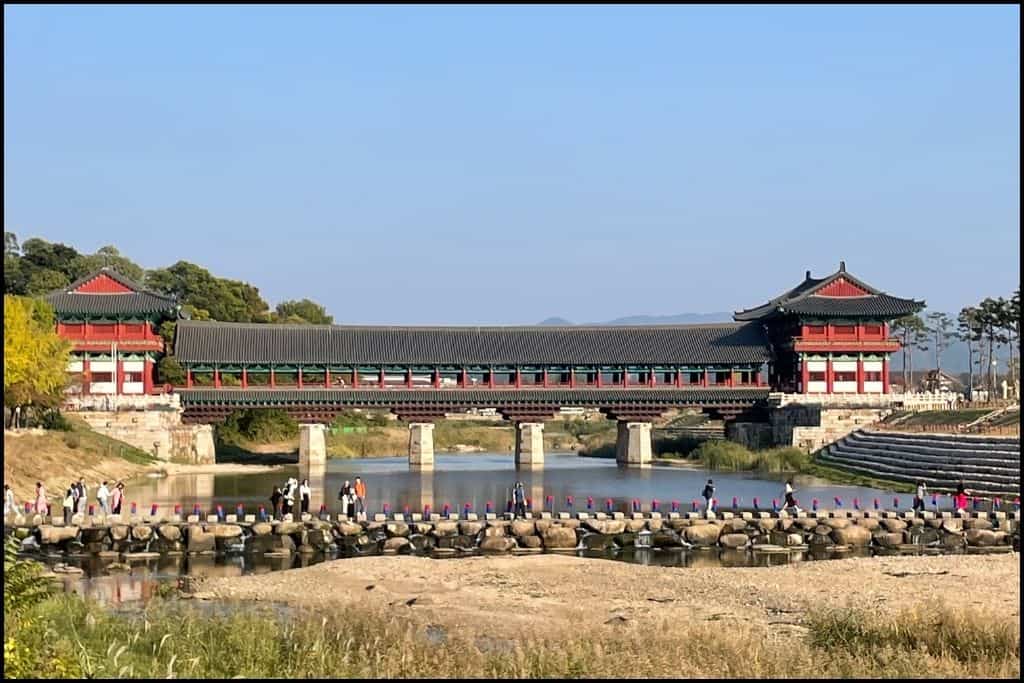
Gyeongju, the ancient capital of the Silla Kingdom, is an ideal day trip destination from Busan.
Known as “the museum without walls,” this city offers an incredible mix of history, culture, and natural beauty. It’s the perfect place to immerse yourself in Korea’s rich heritage, all in a single visit.
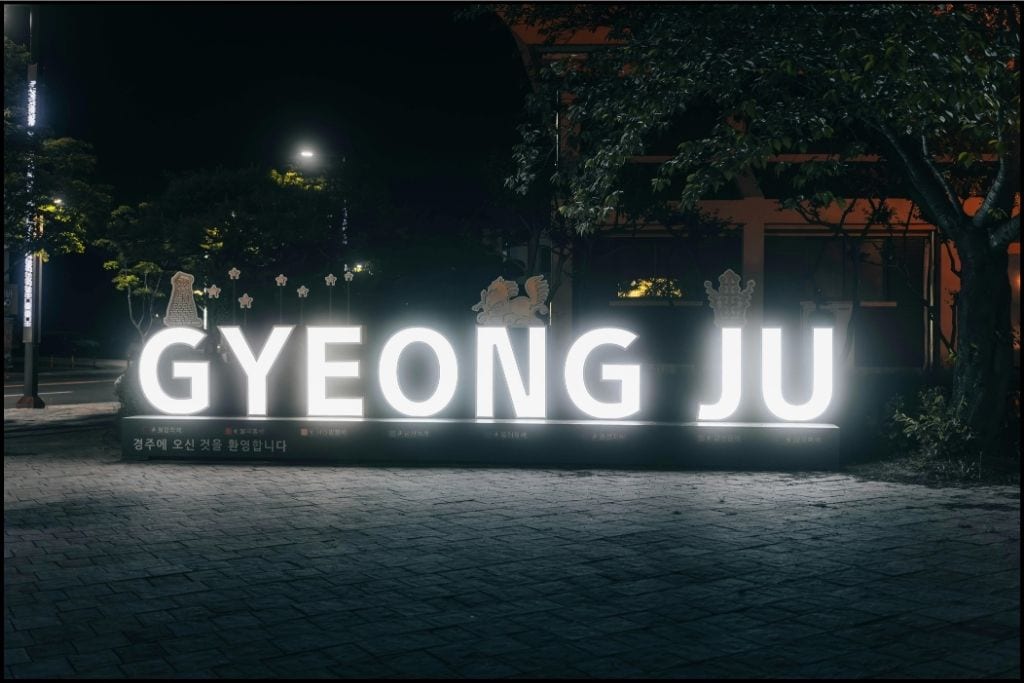
I chose a day tour from Busan, which made exploring Gyeongju a breeze. It was a nice change from my usual routine of planning every detail for my other adventures in Korea.
Hopping on and off the bus at the attractions made the experience both convenient and enjoyable! Click HERE to check pricing and book your Gyeongju day tour now for an unforgettable adventure!
If you’re more of a DIY traveler, you can visit independently and explore the historical sites at your own pace! I’d recommend planning your route beforehand.
In this guide, we’ll dive into the top activities that make Gyeongju the ultimate day trip destination from Busan.
How To Get To Gyeongju From Busan
Getting to Gyeongju from Busan is quick and easy! You can take the KTX from Busan Station to Singyeongju Station, which takes around 30 minutes.
From there, you will need to take a bus, either bus number 50 or 51, to the city center or the intercity bus terminal, which takes about 20-30 minutes.
Alternatively, you can opt for an express or intercity bus from Busan’s Central Bus Terminal (at Nopo Station, Subway Line 1) to Gyeongju Bus Terminal, with a travel time of about 1 hour. Depending on where you are in Busan, the ride to Nopo station can take some time.
DIY Travel Tip: Gyeongju’s bus, No. 10, is called the ”Golden Line” because it passes through all the main attractions in the city. Just make sure to check out the route and plan accordingly. The number 11 bus hits all the same stops, just in the opposite direction. For more info, click HERE
Gyeongju’s city center features several key attractions like the Ancient Tombs, Cheomsongdae, and Hwangnidangil, all within walking distance of one another.
Donggung Palace, Wolji Pond, and the National Museum are a 20–30 minute walk or a short bus ride away from those mentioned above.
For farther sites like Bulguksa Temple, Seokguram Grotto, or Woljeonggyo Bridge, you’ll need to rely on public transportation or a taxi. To make the most of your day, plan your route and consider using Gyeongju’s efficient bus system or taking a taxi for longer trips.
Top Things to Do in One Day
Daereungwon Tomb Complex: A Walk Through Korea’s Ancient Royal History
The Daereungwon Tomb Complex, also known as Tumuli Park, is one of the must-see attractions in Gyeongju. This park is home to 23 large burial mounds, the ancient tombs of Silla royalty and nobility.

Consider renting a hanbok to wear while walking through the lush green landscape dotted with these rounded mounds.
One of the highlights of Tumuli Park is the chance to enter Cheonmachong Tomb, the only burial mound open to the public. Inside, you’ll see a fascinating display of artifacts, including a replica of a golden crown and items buried with the deceased to signify their status.

It’s a fantastic opportunity to learn about the Silla Kingdom’s burial customs and royal lifestyle.
Hwangridan-gil: Gyeongju’s Trendy Street of Cafes and Boutiques
A short walk from the Daereungwon Tomb Complex, Hwangnidangil Street is a vibrant area brimming with charm. This trendy street is one of the top things to do in Gyeongju.

It has quaint cafes, boutiques, and fun restaurants housed in traditional Hanok buildings. Despite the abundance of excellent Korean food choices, I chose a Mexican restaurant. The ambiance was contemporary, and the cuisine was superb.
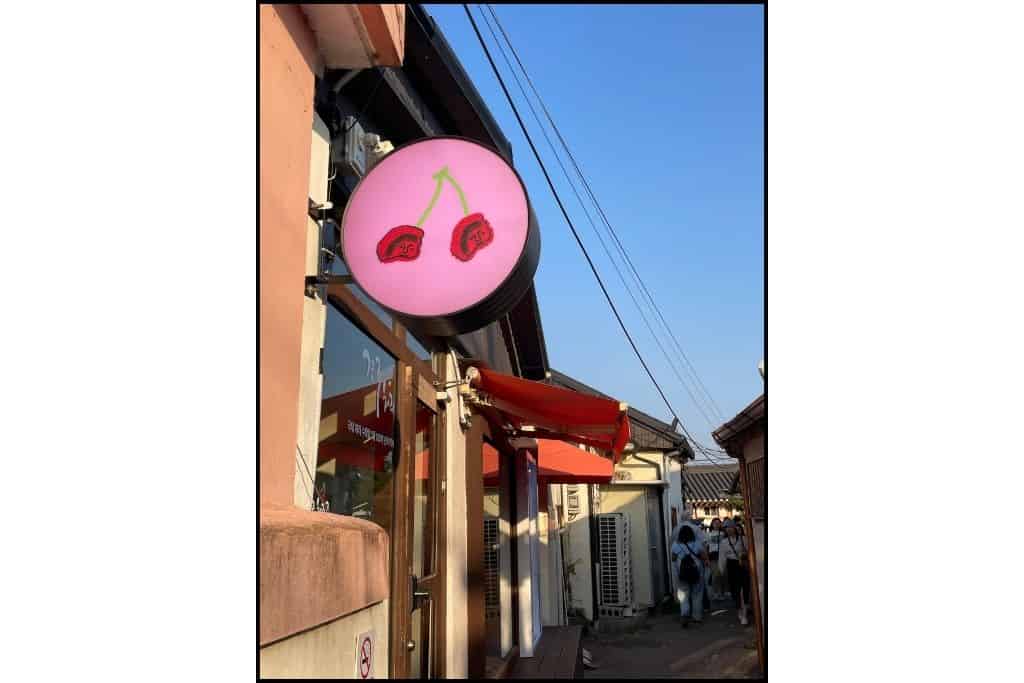
Beyond the cafes and stores, Hwangnidangil is an excellent location for photography because of its unique fusion of contemporary design and traditional charm.
While wandering, street food lovers can also find snacks like hotteok and tteok galbi skewers. Also, look for the cherry soju, Gyeongju’s specialty.
This lively street truly captures the essence of Gyeongju’s balance between history and contemporary culture.
Cheomseongdae Observatory: The Oldest Observatory in East Asia
Another short walk from the Hwanglidangil Street area, Cheomseongdae Observatory is a must-visit and one of Gyeongju’s top things to do.
This iconic stone tower, the oldest surviving astronomical observatory in Asia, dates back to the Silla Kingdom. It offers a fascinating glimpse into ancient Korea’s scientific achievements.

Surrounded by flower fields in spring and vibrant greenery in summer, Cheomseongdae is perfect for a quick stop and photos.
Visiting at night adds a magical touch, as the tower is beautifully illuminated. Pair your visit with a stroll around the nearby Gyerim Forest or Wolseong Palace Site for a complete experience.
Gyeongju National Museum: Uncovering Korea’s Ancient Treasures
A short bus ride or 20-minute walk from Cheomseongdae Observatory, the Gyeongju National Museum is a must-see activity for history lovers.
This museum showcases thousands of artifacts from the Silla Kingdom, including the stunning golden crowns and ancient relics unearthed from royal tombs. It’s a treasure trove of cultural heritage.
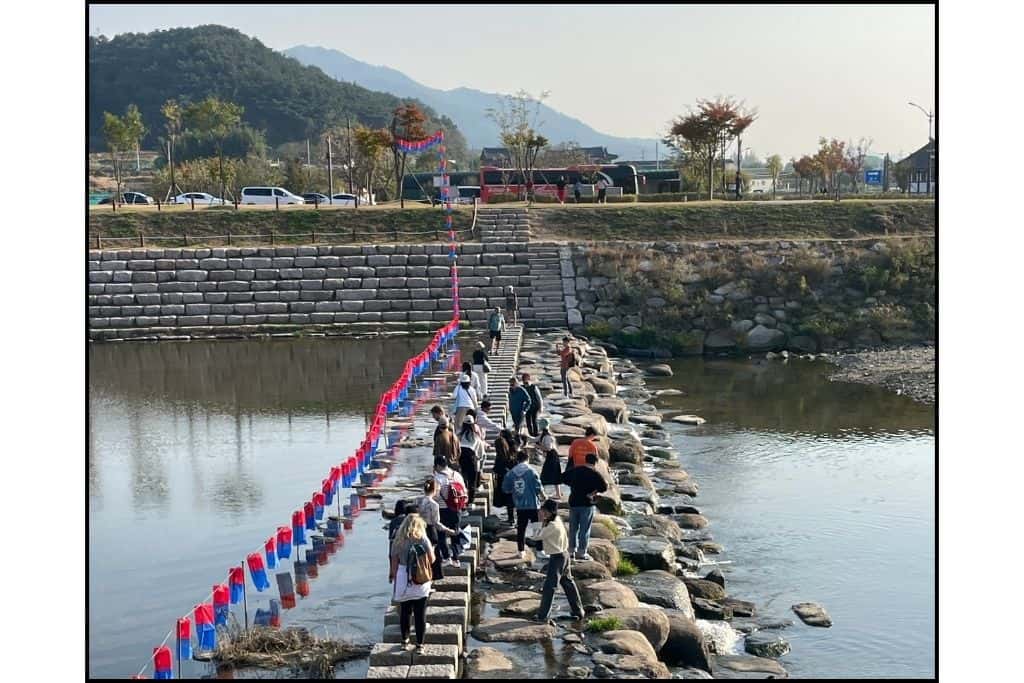
The museum grounds are beautifully landscaped, offering a serene atmosphere for a leisurely visit. On the way to the museum, don’t miss the famous Emille Bell, one of Korea’s biggest and most exquisite bells, displayed outdoors.
Gyeongju Gyochon Traditional Village: Step Back in Time
Consider a taxi or take the 20-minute walk from Gyeongju National Museum to Gyochon Traditional Village, a popular activity for those wanting to experience traditional Korean culture.
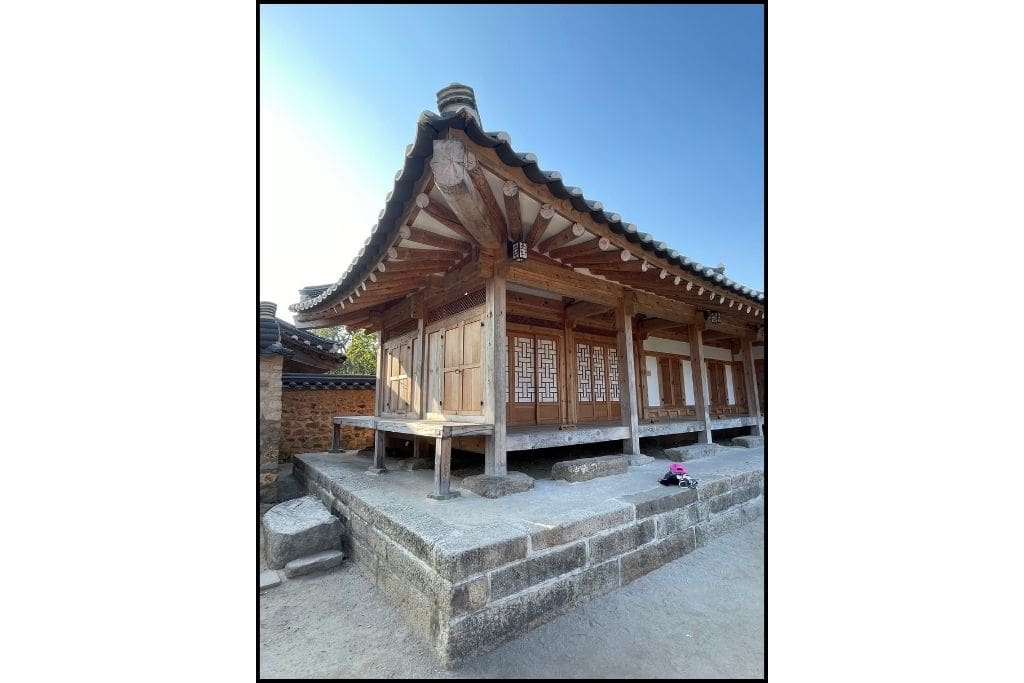
This charming village is home to well-preserved Hanok houses and offers a glimpse into life during the Silla era.
You can discover Korea’s ancient Confucian family customs at the Choi Clan House, which is a must-see while visiting Gyochon.

Stroll through its scenic streets, then grab local snacks and soak in the timeless atmosphere of this cultural gem.
Woljeonggyo Bridge: A Picturesque Icon of Gyeongju’s Heritage
In the same area as Gyochon Traditional Village, Woljeonggyo Bridge is a stunning reconstructed wooden bridge and a top attraction in Gyeongju.

Originally built during the Unified Silla period, the bridge showcases intricate architecture and vibrant colors. It’s an iconic spot for history lovers and photography enthusiasts alike.
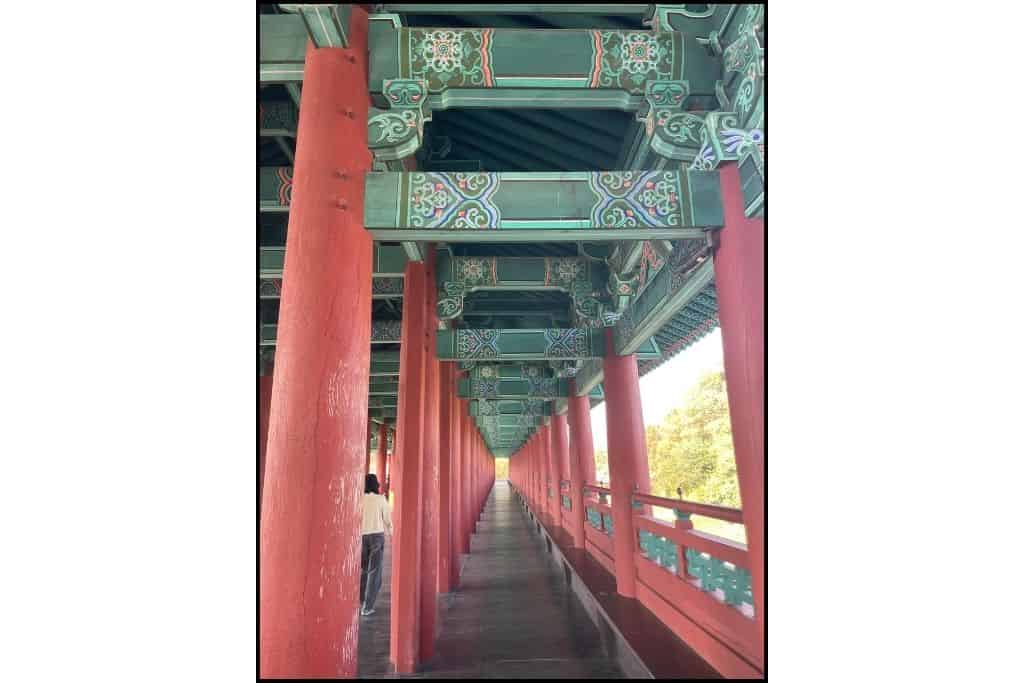
The bridge is especially enchanting at night when beautifully illuminated, creating a magical reflection on the river below. Take a leisurely stroll across the bridge to enjoy panoramic views of the surrounding area.
Pair your visit with Gyochon Village for a perfect mix of culture, history, and scenic beauty.
Donggung Palace and Wolji Pond: A Glimpse into Ancient Korean Royalty
A bus ride or 20-minute walk from the Woljeonggyo Bridge area takes you to Donggung Palace and Wolji Pond, a must-see thing to do in the area.

Once part of a Silla royal palace, this site is steeped in history and features a serene pond surrounded by reconstructed palace buildings.
Visiting at night is the best time, as the illuminated palace and its shimmering reflection on the pond create a breathtaking view.

Stroll along the paths, soak in the tranquil atmosphere, and capture stunning photos of this iconic site. It’s a magical way to end your day in Gyeongju.
Bulguksa Temple: A Sacred Jewel of Gyeongju’s Spiritual History
Bulguksa Temple is one of the top things to do in Gyeongju. It is nestled at the base of Tohamsan Mountain, making it out of the way from the other sites.
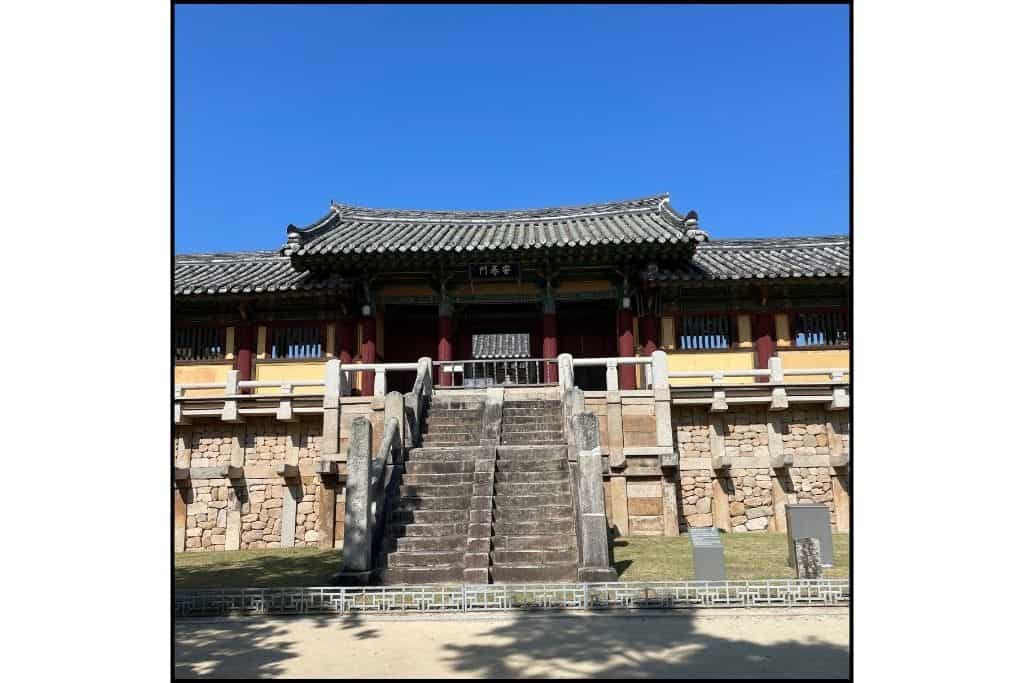
This UNESCO World Heritage site is renowned for its stunning architecture, including two iconic stone pagodas and beautiful temple grounds. It’s an unmissable stop for history and culture enthusiasts.

Bulguksa is a sprawling temple complex with multiple structures to explore, offering a rich spiritual and historical experience. If you visit, check out Seokguram Grotto, another nearby UNESCO site home to the famous stone Buddha statue.
For more info, click HERE
Seokguram Grotto: A Sacred Sanctuary in the Mountains
Seokguram Grotto is another top thing to do in Gyeongju. This UNESCO World Heritage site offers a fascinating glimpse into Korea’s Buddhist heritage.
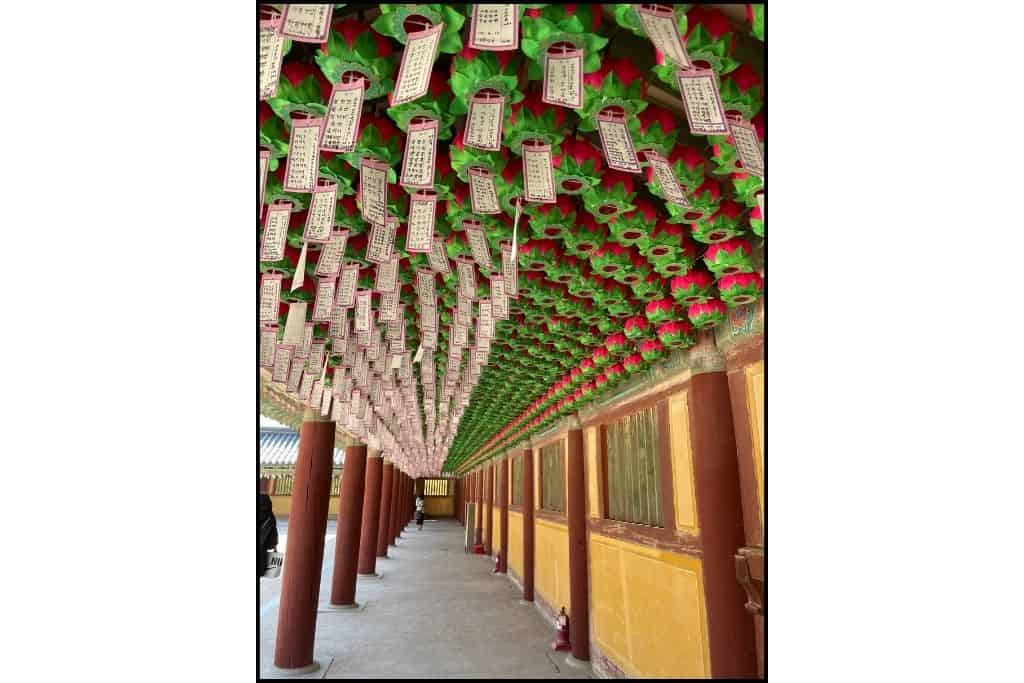
Nestled on the slopes of Mount Tohamsan, Seokguram Grotto provides a peaceful and serene setting.
Because of its proximity to Bulguksa Temple, many tourists decide to visit both locations simultaneously, enjoying the contrast between the vast temple complex of Bulguksa and the small-scale mountaintop experience of Seokguram.
For more info, click HERE
Consider staying overnight and visiting these early the following day. These are in the mountains and take some time to reach. My day tour brought us to the temple as our first stop. Otherwise, I probably wouldn’t have made the trek to see it.
It is famous for its stunning stone Buddha statue carved into the mountainside. The grotto is an awe-inspiring destination for history and spirituality lovers.
Where To Stay
📍 Gyeongju GG Tourist Hotel
A great location near the Intercity Bus Terminal makes Gyeongju GG Tourist Hotel a convenient base for exploring the city’s historic sites, with comfortable rooms and modern amenities for a relaxing stay. Click HERE to check pricing and book your room.
📍 Rivertain Hotel Gyeongju
A stylish and comfortable stay in a prime location near the Intercity Bus Terminal, allowing easy access to the city’s historic sites, restaurants, and shopping areas. With modern amenities and well-appointed rooms, it’s a great choice for both relaxation and convenience. Click HERE to check pricing and reserve your stay.
📍 Gyeongju Hanokstay Darak
Offers a unique experience with traditional Korean hanok-style accommodations, blending comfort and cultural charm. Located centrally, it’s an ideal base for exploring Gyeongju’s historic sites, while providing a peaceful and authentic atmosphere with modern amenities. Click HERE to check pricing and book your experience.
FAQ
Gyeongju is famous for its traditional rice cakes called “ssambap” and “hanjeongsik,” a multi-course Korean meal. Don’t miss out on trying the city’s unique dishes at local restaurants or street food stalls.
Also, dont miss Gyeongju’s cherry wine. It offers a unique and refreshing flavor, capturing the sweetness of the region’s cherries.
The best time to visit Gyeongju is during the spring (April to June) and autumn (September to November) when the weather is mild, and the city’s historical sites are surrounded by beautiful natural scenery, including vibrant cherry blossoms or autumn leaves.
Gyeongju has a convenient public transportation system, including buses and taxis. If you prefer a more relaxed experience, consider joining a day tour to easily visit the main attractions. Click HERE to inquire about a day tour.
Key attractions include Bulguksa Temple, Seokguram Grotto, Cheomseongdae Observatory, Gyeongju National Museum, and the ancient tombs at Daereungwon Tomb Complex. You can also visit the scenic Wolji Pond and Donggung Palace.
Absolutely! Gyeongju is a peaceful and safe city, and solo travelers can enjoy exploring its historic sites with ease. The friendly locals and easy-to-navigate transportation make it a welcoming destination for all types of travelers.
As a solo traveler myself, I chose to go on a day tour, and it was a great decision. You’ll definitely feel safe exploring Gyeongju on your own, as the city is peaceful and easy to navigate. Click HERE to book your Gyeongju day tour.
For a well-rounded experience, plan at least two to three days in Gyeongju to fully appreciate the city’s historical sites, parks, and museums.
If you have limited time, a one-day tour focusing on key spots will still offer a memorable visit.
Wrap Up
Gyeongju offers a perfect blend of ancient history and modern charm, making it an essential destination for anyone interested in exploring Korea’s rich cultural past.
You can choose to take a guided day tour for a hassle-free experience, visiting iconic sites like Bulguksa Temple and Cheomseongdae Observatory. Or you can venture out on your own for a more personal exploration of the city’s fascinating landmarks.
Whether you’re wandering through tombs, temples, or scenic parks, every corner of Gyeongju holds a story that connects you to Korea’s royal history.
With its UNESCO World Heritage sites and deep-rooted historical significance, Gyeongju stands as a living museum, offering visitors a rare glimpse into Korea’s ancient civilization.

